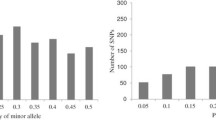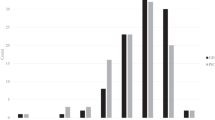Abstract
Heterotic groups and patterns are of fundamental importance in hybrid breeding. The objectives of our research were to: (1) investigate the relationship of simple sequence repeats (SSR) based genetic distances between populations and panmictic midparent heterosis (PMPH) in a broad range of CIMMYT maize germplasm, (2) evaluate the usefulness of SSR markers for defining heterotic groups and patterns in subtropical germplasm, and (3) examine applications of SSR markers for broadening heterotic groups by systematic introgression of other germplasm. Published data of two diallels and one factorial evaluated for grain yield were re-analyzed to calculate the PMPH in population hybrids. Additionally, 20 pools and populations widely used in CIMMYT's breeding program were assayed with 83 SSR markers covering the entire maize genome. Correlations of squared modified Roger's distance (MRD2) and PMPH were mostly positive and significant, but adaption problems caused deviations in some cases. For intermediate- and early-maturity subtropical germplasm, two heterotic groups could be suggested consisting of a flint and dent composite. We concluded that the relationships between the populations obtained by SSR analyses are in excellent agreement with pedigree information. SSR markers are a valuable complementation to field trials for identifying heterotic groups and can be used to introgress exotic germplasm systematically.


Similar content being viewed by others
References
Beck DL, Vasal SK, Crossa J (1991) Heterosis and combining ability among subtropical and temperate intermediate-maturity maize germplasm. Crop Sci 31:68–73
Boppenmaier J, Melchinger AE, Seitz G, Geiger HH, Herrmann RG (1993) Genetic diversity for RFLPs in European maize inbreds. III. Performance of crosses within versus between heterotic groups for grain traits. Plant Breed 111:217–226
Brummer EC (1999) Capturing heterosis in forage crop cultivar development. Crop Sci 39:943–954
Charcosset A, Lefort-Buson M, Gallais A (1991) Relationship between heterosis and heterozygosity at marker loci: a theoretical computation. Theor Appl Genet 81:571–575
Charcosset A, Essioux L (1994) The effect of population structure on the relationship between heterosis and heterozygosity at marker loci. Theor Appl Genet 89:336–343
CIMMYT (1998) A complete listing of maize germplasm from CIMMYT. Maize Program Special Report, Mexico DF, Mexico
Comstock RE, Robinson HF (1948) The components of genetic variance in populations of biparental progenies and their use in estimating the average degree of dominance. Biometrics 4:254–266
Cress CE (1966) Heterosis of the hybrid related to gene-frequency differences between two populations. Genetics 53:269–274
Crossa J, Vasal SK, Beck DL (1990) Combining ability estimates of CIMMYT tropical late yellow maize germplasm. Maydica 35:273–278
Elder JK, Souther EM (1987) Computer-aided analysis of one-dimensional restriction fragments gels. In: Bishop MJ, Rawling CJ (eds) Nucleid acid and protein sequence analysis – a practical approach. IRL Press, Oxford, pp 165–172
Falconer DS, Mackay TF (1996) Introduction to quantitative genetics, 4th edn. Longman Group Ltd, London
Fisher RA (1921) On the "probable error" of a coefficient of correlation deduced from a small sample. Metron 1:1–32
Frisch M, Bohn M, Melchinger AEM (2000) Plabsim: software for simulation of marker-assisted backcrossing. J Hered 91:86–87
Gardner CO, Eberhart SA (1966) Analysis and interpretation of the variety cross diallel and related populations. Biometrics 22:439–452
Goodman MM, Stuber CW (1983) Races of maize. VI. Isozyme variation among races of maize in Bolivia. Maydica 28:169–187
Gower JC (1966) Some distance properties of latent root and vector methods used in multivariate analysis. Biometrika 53:325–338
Hallauer AR, Russell WA, Lamkey KR (1988) Corn breeding. In: Sprague GF, Dudley JW (eds) Corn and corn improvement, 3rd edn. Agron Monogr 18, ASA, CSSA and SSSA, Madison, Wisconsin, pp 463–564
Hartigan JA, Wong MA (1979) A K-means clustering algorithm. Appl Stats 28:100–108
Ihaka R, Gentleman R (1996) A language for data analysis and graphics. J Computat Graphical Stats, Vol 5 3:299–314
Lamkey KR, Edwards JW (1999) Quantitative genetics of heterosis. Chapter 10. In: Coors JG, Pandey S (eds) The genetics and exploitation of heterosis in crops. CSSA, Madison, Wisconsin
Lu H, Bernardo R (2001) Molecular marker diversity among current and historical maize inbreds. Theor Appl Genet 103:613–617
Melchinger AE (1993) Use of RFLP markers for analysis of genetic relationship among breeding materials and prediction of hybrid performance. In: International Crop Science I. CSSA, Madison, Wisconsin, pp 621–628
Melchinger AE (1999) Genetic diversity and heterosis. Chapter 10. In: Coors JG, Pandey S (eds) The genetics and exploitation of heterosis in crops. CSSA, Madison, Wisconsin
Melchinger AE, Gumber RK (1998) Overview of heterosis and heterotic groups in agronomic crops. In: Lamkey KR, Staub JE (eds) Concepts and breeding of heterosis in crop plants, CSSA, Madison, Wisconsin, pp 29–44
Melchinger AE, Lee M, Lamkey KR, Woodman WL (1990) Genetic diversity for restriction fragment length polymorphisms: relation to estimated genetic effects in maize inbreds. Crop Sci 30:1033–1040
Melchinger AE, Messmer MM, Lee M, Woodman WL, Lamkey KR (1991) Diversity and relationships among US maize inbreds revealed by restriction fragment length polymorphisms. Crop Sci 31:669–678
Michalakis Y, Excoffier L (1996) A generic estimation of population subdivision using distances between alleles with special reference for microsatellite loci. Genetics 142:1061–1064
Moll RH, Salhuana WS, Robinson HF (1962) Heterosis and genetic diversity in variety crosses of maize. Crop Sci 2:197–198
Moll RH, Longquist JH, Fortuna JV, Johnson EC (1965) The relation of heterosis and genetic divergence in maize. Genetics 52:139–144
Ron Parra J, Hallauer AR (1997) Utilization of exotic maize germplasm. Plant Breed Rev 14:165–187
Saghai-Maroof MA, Soliman KM, Jorgenson R, Allward RW (1984) Ribosomal DNA spacer length polymorphisms in barley: Mendelian inheritance, chromosomal location and population dynamics. Proc Natl Acad Sci USA 81:8014–8018
Schneider S, Roessli D, Excoffier L (2000) Arlequin, ver 2.0: a software of population genetics data analysis. Genetics and Biometry Laboratory, University of Geneva, Switzerland
Senior ML, Murohy MM, Goodman MM, Stuber CW (1998) Utility of SSRs for determining genetic similarities and relationships in maize using an agarose gel system. Crop Sci 28:63–67
Smith JSC, Chin ECL, Shu H, Smith OS, Wall SJ, Senior ML, Mitchell SE, Kresovitch S, Ziegle J (1997) An evaluation of the utility of SSR loci as molecular markers in maize (Zea mays L.): comparisons with data from RFLPs and pedigree. Theor Appl Genet 95:163–173
Vasal SK, Srinivasan G, Crossa J, Beck DL (1992a) Heterosis and combining ability of CIMMYT's subtropical and temperate early maturity maize germplasm. Crop Sci 32:884–890
Vasal SK, Srinivasan G, Beck DL, Crossa J, Pandey S, Leon C de (1992b) Heterosis and combining ability of CIMMYT's tropical late white maize germplasm. Maydica 37:217–223
Vasal SK, Srinivasan G, Gonzalez F, Han GC, Pandey S, Beck DL, Crossa J (1992c) Heterosis and combining ability of CIMMYT's tropical × subtropical maize germplasm. Crop Sci 32:1483–1489
Vasal SK, Cordova HS, Pandey S, Srinivasan G (1999) Tropical maize and heterosis. Chapter 34. In: Coors JG, Pandey S (eds) The genetics and exploitation of heterosis in crops. CSSA, Madison, Wisconsin
Warburton ML, Xia XC, Crossa J, Franco J, Melchinger AE, Frisch M, Bohn M, Hoisington D (2002) Genetic characterisation of CIMMYT maize inbred lines and open-pollinated populations using large scale fingerprinting methods. Crop Sci (in press)
Wellhausen EJ (1978) Recent developments in maize breeding in the tropics. In: Walden DB (ed) Maize breeding and genetics. John Wiley and Sons, New York, pp 59–91
Wright S (1978) Evolution and genetics of populations, vol. IV. The University of Chicago Press
Acknowledgements
The molecular marker analyses of this research were supported by funds from the German "Bundesministerium für wirtschaftliche Zusammenarbeit und Entwicklung" Project No. 98.7860.4-001-01. Thanks to J. Crossa, G.C. Han, S. Pandey, and G. Srinivasan for providing the field data and seeds for performing this study. This paper is dedicated to Prof. Dr. h. c. F. W. Schnell on the occasion of his 90th birthday.
Author information
Authors and Affiliations
Corresponding author
Additional information
Communicated by F. Salamini
Rights and permissions
About this article
Cite this article
Reif, J.C., Melchinger, A.E., Xia, X.C. et al. Use of SSRs for establishing heterotic groups in subtropical maize. Theor Appl Genet 107, 947–957 (2003). https://doi.org/10.1007/s00122-003-1333-x
Received:
Accepted:
Published:
Issue Date:
DOI: https://doi.org/10.1007/s00122-003-1333-x




